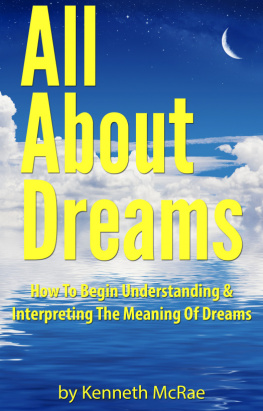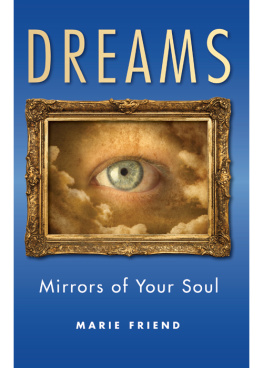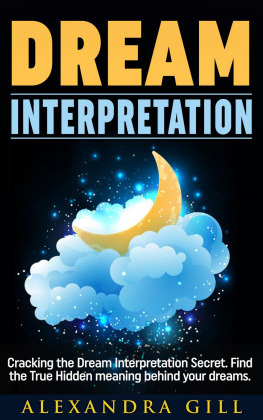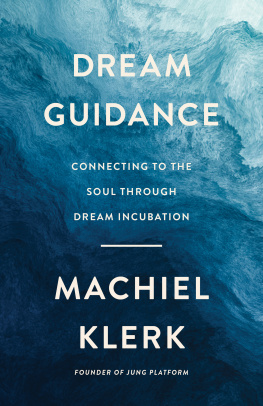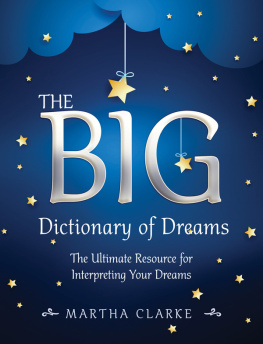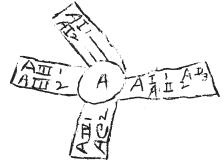A whole world inside us is asleep. We wake to it but rarely.
We glimpse and barely remember. Or we dont understand what weve seen.
A third of our time on earth weve spent sleeping, with little to show: an image, a face. Only rarely does a dream come that wakes us to ourselves.
Will our lives someday be forgotten as we have forgotten our dreams?
I know there is a conscious mind and an unconscious. But I dont always think about what that impliesthat more than half of who I am and what I am is completely unknown to me, except in fragments and glimpses, images and dreams.
Is it possible that all we dont know about ourselves includes also the most important thing? That our self-knowledge is trivial by comparison, and yet we use only our conscious awareness to guide our lives? And so we miss receiving great gifts that have been waiting for us all along.
To receive these gifts, we must learn how to dream, which sounds easy enough. But I mean dreaming with a purpose, learning to use dreaming as a way to depth. That proved difficult, at least for me.
I had to make a wayward pilgrims progress to the dream because I had so much to unlearnand I am a slow unlearner. The progress falls into three parts, which Ive titled Images, Interpretations, and Dreams.
First I had to learn the true power of images. Then I had to unlearn the ancient reflexes of interpretation. Only then could I explore the world of dreams.
In part one of this book I introduce my first teacher, an eighty-seven-year-old Algerian-born mystic living in Jerusalem whom we students called Colette. My encounter with this powerful personality was a once-in-a-lifetime adventure full of strange, hilarious, and sometimes harrowing incidents, like the time she tried to lengthen my arms an extra inch. But she taught me the valuable ancient practice of directed waking dreams. This practice reverses the flow of ordinary thought, taking words back to images. By this reversing, I understood for myself, as she often said, that images are sovereign in the mind.
Part one, then, deals with one obstacle to dreams, which is the habit of thinking in words; part two concerns the habit of interpretation, which is another barrier. I introduce Marc Bregman, my teacher of dreams as Colette was my teacher of images. We struggled together over a puzzling dream about reading a book, a huge blue book that seemed to be a commentary on Genesis. Before I could fully enter the realm of dreams, it seems, I had to unlearn the habit of interpretation. This habit is so thickly and deeply rooted in ancient history and religion and modern psychology that it feels like the only and natural response to dreams. But there is another approach to dreams, and this is what I needed to learn.
So in part two of my wayward progress, I dig up the roots of interpretation in Genesis and follow them where they lead: to the influential dream theories of the rabbinic sages and Church Fathers, all the way to Freud. I learned for myself how in every age, interpretation has repressed the power of the dream.
Only then could Marc Bregman teach me to undo interpretation and enter directly into the world of dreams, the journey explored in the third part of this book. Here he proved as shamanic a master as a contemporary American can be who wears red flannel shirts and hunts moose and drives a Chevy Avalanche.
What I experienced in dreams became not only real for me, but the touchstone for what is real.
But to explain that paradox more clearly, I have to back up and give a brief spiritual and personal history of who I was when I met him.
T o all appearances I was awake the summer afternoon I first met Marc Bregman. But I was also unconscious in important ways. I had no awareness of my true predicament in life, though my dreams would soon demonstrate it vividly.
All I knew was, I needed a fresh start. Three frustrating years of work on a book project had ended in failure. It was a book about religion, and a major impasse was that I no longer felt sure in the truths I was writing about. The gap between what I wanted to believe and what I felt inside was wide; the empty space between belief and feeling troubled me.
I am very comfortable with words and metaphors, with books and ideas. I enjoy explicating religious doctrine. I love the stories and the stories about the stories, the commentaries and the traditions. But in the back of my mind, disquiet whispered: What if all this talk is about nothing? What if it isnt real?
I was not raised in a religious home. My extended family were good people; we loved our roots and tradition. The rituals we did were all about family, and warmth, and being together. Our grandparents had traded the Old World for the New, and theyd brought with them the warmth and the family closeness but had left the piety behind.
My family did not pray in a crisis; we worried. Our faith was in ourselves: in what we could see with our eyes and touch with our hands, in hard work, and, for the children, in school. Education was everything: with education you could become a doctor, a lawyer; you could be somebody. We were striving to fulfill the American promise: it was a story our grandparents began by immigrating, and we were completing it with our little triumphs. It was all very practical and obvious. This was how we lived.
I dont recall God being taken seriously in anyones mouth.
I wasnt gifted with a simple faith, like the man my father told me about once who never prayed in the community: while others worshipped, he walked in the park and talked to God.
My interest in religious consciousness came in my adult life, and it was an anomaly among my family and most of my friends. It came through certain teachers Id met, and those Ive written about. A lot of it came from books.
I once had a very pious friend. He observed all the rules; he prayed every day. One morning, while praying, he realized he was talking to a wall. That was the end of the religious life for him.


